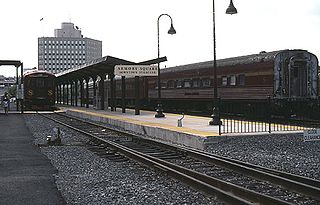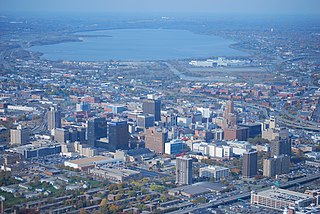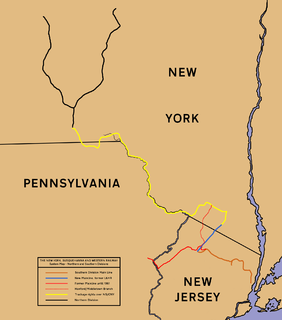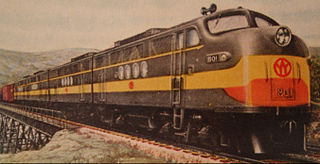
Oswego is a city in Oswego County, New York, United States. The population was 18,142 at the 2010 census. Oswego is located on Lake Ontario in north-central New York and promotes itself as "The Port City of Central New York." It is the county seat of Oswego County.

Armory Square is a small neighborhood on the west side of Downtown Syracuse, New York. It began life as a busy commercial and industrial area just to the west of the central city. After World War II, Syracuse's central city became less and less populated as more housing and business facilities were built in the suburbs. In the 1980s, plans were first made to transform the languishing district into a small shopping/arts/nightlife district surrounding the former Syracuse Armory. These plans came to fruition during the 1990s, when new stores and restaurants opened, and several new buildings were constructed in a compatible style to the middle and late 1800s and early 1900s architecture dominating the district.
The Erie Railroad was a railroad that operated in the northeastern United States, originally connecting New York City — more specifically Jersey City, New Jersey, where Erie's former terminal, long demolished, used to stand — with Lake Erie. It expanded west to Chicago with its 1941 merger with the former Atlantic and Great Western Railroad, also known as the New York, Pennsylvania and Ohio Railroad. Its mainline route proved influential in the development and economic growth of the Southern Tier of New York State, including cities such as Binghamton, Elmira, and Hornell. The Erie Railroad repair shops were located in Hornell and was Hornell's largest employer. Hornell was also where Erie's mainline split into two routes, one north to Buffalo and the other west to Cleveland.

OnTrack was a suburban rail line that operated in Syracuse, New York, from 1994 to 2008. During much of its operation, Syracuse was the smallest city in the United States to have regional train service. The line ran from the Carousel Center on the city's north side via Armory Square and Syracuse University to Colvin Street, with summer weekend service south to Jamesville, mainly using 1950s-era diesel railcars.

Downtown Syracuse is the economic center of Syracuse, New York, and Central New York, employing over 30,000 people, and housing over 4,000.

The Delaware, Lackawanna & Western Railroad was a U.S. Class 1 railroad that connected Buffalo, New York, and Hoboken, New Jersey, a distance of about 400 miles (640 km). Incorporated in 1853, the DL&W was profitable during the first two decades of the twentieth century, but its margins were gradually hurt by declining traffic in coal and competition from trucks. In 1960, the DL&W merged with rival Erie Railroad to form the Erie Lackawanna Railroad.

The New York, Susquehanna and Western Railway is a Class II American freight railway operating over 400 miles (645 km) of track in the northeastern U.S. states of New York, Pennsylvania, and New Jersey.

The Rome, Watertown and Ogdensburg Railroad was a railroad that grew, in stages, from Rome, New York to Watertown and then to Ogdensburg, New York and Massena, New York. The original Rome and Watertown Railroad terminated in Cape Vincent, NY on the St Lawrence River. A branch of the Rome, Watertown and Ogdensburg Railroad, commonly known as The Hojack Line, operated along the south shore of Lake Ontario, from Oswego, New York to Niagara Falls, New York.
The Oswego and Syracuse Railroad was formed April 29, 1839, and the route was surveyed during the summer of that year. The Company was fully organized March 25, 1847. The road was opened on May 14, 1848, and ran a total distance of 35.5 miles (57.1 km) from Syracuse, New York to Oswego, New York. In 1872 it passed under the management of the Delaware, Lackawanna and Western Railroad.
The Auburn and Syracuse Railroad was incorporated on May 1, 1834, to provide easy access between Syracuse, New York, and the Erie Canal. Construction was begun in 1835, however, was delayed during the Panic of 1837. Although the economic downturn lingered until 1843, the railroad was completed by January 1838.

The New York, Ontario and Western Railway, more commonly known as the O&W or NYO&W, was a regional railroad with origins in 1868, lasting until March 29, 1957 when it was ordered liquidated by a US bankruptcy judge. It was the first notable U.S. railroad with its mainline entirely abandoned.
The Delaware, Lackawanna and Western Railroad's 1151 class comprised five 4-6-4 steam locomotives built by the American Locomotive Company (ALCO) in 1937. They were the last steam locomotives ordered by the railroad.

The William F. Walsh Regional Transportation Center is the long-distance ground travel terminal serving the Syracuse, New York area. It is served by Amtrak, Greyhound Lines, Megabus, and Trailways. Local and regional bus transportation is provided by the Central New York Regional Transportation Authority (CENTRO). Various taxi firms service the Center, as well. The Regional Transportation Center is located on the north side of Syracuse, adjacent to the Central New York Regional Market and near Destiny USA.

The Binghamton was a ferryboat that transported passengers across the Hudson River between Manhattan and Hoboken from 1905 to 1967. Moored in 1971 at Edgewater, Bergen County, New Jersey, United States, the ship was operated as a floating restaurant from 1975 to 2007. In 2017, following ten years of damage that effectively rendered the boat unrestorable, the ferry was dismantled. No structural components were salvaged.

Railroad Terminal Historic District is a national historic district in Binghamton in Broome County, New York. The district includes 19 contributing buildings. Four of the buildings were directly related to Binghamton's rail passenger and freight operations, including the passenger station. Five buildings were built as warehouses, and ten were built to house retail activities with residential or office uses on the upper floors. The buildings were built between 1876 and 1910, with a major addition to one of them completed in 1932. This Delaware, Lackawanna and Western Railroad passenger station, with its Italian Renaissance campanile, was built in 1901. For most years of passenger service to Binghamton Delaware and Hudson Railway and Erie Railroad trains used the station 150 yards away.

Phoebe Snow was a named passenger train which was once operated by the Delaware, Lackawanna and Western Railroad (DL&W) and, after a brief hiatus, the Erie Lackawanna Railway (EL).
The Railroad industry in Syracuse, New York got its start in October 1831 when a convention held in the city marked one of the earliest moves to stimulate the era of railroad building which ultimately brought steam railroad service to New York State.
The Interstate Express was a long-distance passenger train operating between Syracuse, New York, and Philadelphia, Pennsylvania, jointly operated by the Reading Railroad, the Central Railroad of New Jersey and the Delaware, Lackawanna and Western Railroad. These lines offered a long distance overnight line in Train 1301 (north-bound)/ 1306 (south-bound). Connecting service by the Baltimore and Ohio Railroad offered continuing service south from Philadelphia to Washington, D.C.

Cortland station is a defunct Lehigh Valley Railroad station in Cortland, New York. It was located on the Lehigh Valley's Elmira and Cortland Branch. The station building still stands; the tracks are owned by the New York, Susquehanna and Western Railway. Cortland was one of two depots; the Delaware, Lackawanna and Western Railroad (Lackawanna) depot was located on Railroad Street in the center of the city.
Lackawanna Station was the Delaware, Lackawanna and Western's railroad station in Syracuse, New York. It was housed in different buildings in succession. It hosted trains going north to Oswego, New York on the Lake Ontario coast by way of the DLW's acquisition, the former Oswego and Syracuse Railroad; and it also hosted trains going south to Binghamton on the route of the former Syracuse and Binghamton Railroad, and further to Hoboken, New Jersey.













